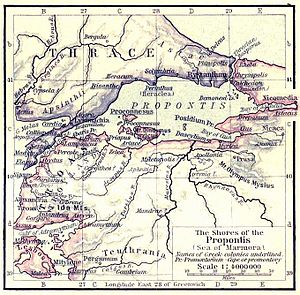Battle of Chalcedon
| date | 409 or 408 BC Chr. |
|---|---|
| place | on the Bosphorus |
| output | Athens wins |
| consequences | Agreement with Pharnabazos , siege of Byzantium |
| Parties to the conflict | |
|---|---|
| Commander | |
| Troop strength | |
| 5,000 hoplites , 70 ships | |
Sybota - Potidaia - Spartolus - Stratos - Naupactus - Plataea - Olpai - Tanagra - Pylos - Sphacteria - Corinth - Megara - Delion - Amphipolis - Mantinea - Melos - Syracuse - Miletus - Syme - Eretria - Kynossema - Abydos - Kyzikos - Ephesus - Chalcedon - Byzantium - Andros - Notion - Mytilene - Arginus - Aigospotamoi
The Battle of Chalcedon was a battle in the Peloponnesian War that took place in early 408 BC. BC, possibly as early as 409 BC BC, a siege army from Athens defeated the defenders of the city of Chalcedon on the Bosphorus . Following the battle, the Athenians succeeded in restoring their rule on the Bosporus with the capture of Chalcedon, Selymbria and Byzantion .
Siege of Chalcedon
After the destruction of the Peloponnesian fleet in the battle of Kyzikos in the spring of 410 BC. The Attic general Alkibiades concentrated his efforts on regaining Athens' lost position on the straits. Immediately after the battle he went to Perinthos and Selymbria in Thrace , but was only allowed into the first city, while the citizens of the second at least paid taxes. Then he fortified the place Chrysopolis on the Bosporus in the territory of the Chalcedonians, where he set up a customs post for the collection of the sound tariff and a garrison with thirty triremes under the command of the generals Theramenes and Eumachos with the order to control the ships passing through and those of Athens to harm fallen cities. Alkibiades himself returned with his main power to Lampsakos on the Hellespont , which he also had fortified. Chalcedon and Byzantium on the Bosporus received support from the Persian satrap Pharnabazos and the Spartan general Klearchus , who broke through the Attic blockade with a few ships in order to take over the defense in Byzantium. At the latest in the year 409 BC. However, Theramenes increased the pressure on Chalcedon and laid down in a permanent camp in front of the walls. Using a natural course of the river, he had the city surrounded by a palisade towards the country and began the siege.
Battle of Chalcedon
The Spartan Harmost Hippocrates , who headed the defense of Chalcedon, initially waited, but when he learned at the beginning of the following year that a Persian aid contingent under the command of Pharnabazos was within reach, he decided to withdraw. Alkibiades had meanwhile increased the Attic presence to 70 ships and 5,000 soldiers, including a contingent of hoplites and light shields under the command of the strategist Thrasyllos . Against these troops the Chalcedonians and Spartans fought within the palisades for a chance to unite with the Persian relief army. After a long battle, the decision was made by the arrival of Alcibiades with the cavalry. Hippocrates fell while his men withdrew behind the walls. The Persians had not been able to intervene in the battle because of the palisade and the river and withdrew to their camp near Herakleion of Chalcedon.
Communication with Pharnabazos
After the battle, Alkibiades and Pharnabazos entered into negotiations, and Theramenes negotiated an agreement under which Chalcedon would formally remain under Persian suzerainty but pay its dues to Athens. The treaty was sworn by Alkibiades and Pharnabazos in Chrysopolis and Chalcedon. Soon afterwards, the city seems to have been completely under Athenian control again. The more important goal, the split of the Spartan-Persian alliance, was missed, however, as further negotiations with the great king came to nothing.
Conquest of Byzantium
| date | 408 BC Chr. |
|---|---|
| place | on the Bosphorus |
| output | Athens wins |
| consequences | Triumph of Alcibiades in Athens |
| Parties to the conflict | |
|---|---|
| Commander | |
|
Klearchos , Koiratadas, Helixos |
|
| Troop strength | |
| 5,000 hoplites , 70 ships, Thracians , Chersonese | Spartan Periöken and Neodamoden , Boioter, Megarer |
During the negotiations, the Athenians crossed over to the European side of the Bosporus, where they included the city of Byzantion, which was defended by the Spartan Klearchus , the Boioter Koiratadas and the Megarer Helixos. While Theramenes led the siege, Alcibiades went to conquer Selymbria. After this had succeeded in a surprise coup, he brought in further reinforcements from Thrace and the Hellespont. Finally, a ruse was used to capture Byzantion, with several traitors in the city helping by letting the Athenians in through one of the gates.
Result
With the capture of Chalcedon and Byzantium, his last great deed in the service of Athens, Alcibiades had almost completely regained the lost positions of the Attic Empire on the straits. With the help of the grain from the Black Sea and the income from the sound tariff, Athens was able to continue the war for five years before it finally had to succumb to the Peloponnesian-Persian superiority.
Individual evidence
- ↑ On the controversial chronology of this time cf. about Bruno Bleckmann : Athens' path to defeat. The last years of the Peloponnesian War . Teubner, Stuttgart 1998, ISBN 3519076489 , especially pp. 267-314.
- ↑ Xenophon , Hellenika , I 1, 20-22.
- ↑ Xenophon , Hellenika , I 3, 2-7; Diodor , Bibliothek , XIII 66, 1-2; Plutarch , Alkibiades , 30.
- ↑ Xenophon, Hellenika , I 3, 8-13; Diodor, Bibliothek , XIII 66, 3; Plutarch, Alkibiades , 31.
- ↑ Xenophon, Hellenika , I 3, 14-22; Diodor, Bibliothek , XIII 66, 3-67.7; Plutarch, Alkibiades , 31.
